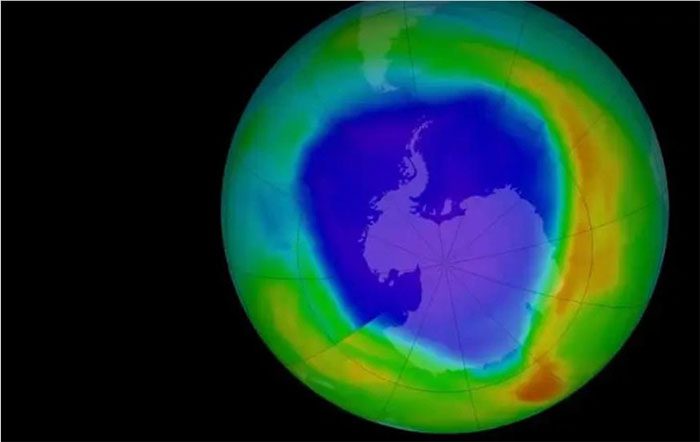NASA scientists predicted that the Earth’s ozone hole would expand significantly in 2023, but they now admit their calculations were extremely off.
Following the Tonga-Hunga volcano eruption in 2022, which released a massive amount of water into the atmosphere, NASA scientists reported that we should prepare for a large ozone hole over Antarctica in the fall of 2023.

A heat map showing the ozone hole on Earth – (Source: NASA)
Paul Newman, the head of NASA’s ozone research team and chair of the Earth Sciences Department at the Goddard Space Flight Center, previously stated: “It’s a very large scale. It’s bad for people living in ozone-depleted areas” in southern South America.
However, that did not happen, according to the Associated Press.
Instead, the ozone hole in 2023 was of average size for the past 20 years, even slightly smaller than in 2022, according to the latest information from NASA and the National Oceanic and Atmospheric Administration (NOAA).
From September to mid-October, the 2023 ozone hole averaged 23.1 million square kilometers, ranking as the 16th largest since satellite monitoring began in 1979.
“Things are not as bad as we thought. We were wrong,” Newman said.
Why did NASA predict the ozone layer would worsen?
When the Hunga Tonga Hunga Ha’apai volcano shot millions of tons of water into the Southern Hemisphere’s atmosphere in January 2022, scientists believed that an excess of 10% water would harm the ozone layer.
This is because liquid water in the upper atmosphere facilitates the attachment and corrosion of chlorine and bromine, which leads to an increasing ozone hole each year, Newman explained. Therefore, scientists and computer models predicted a bad ozone season in 2023.
Newman stated that researchers will need to determine where their computer simulations went wrong.
The ozone hole has improved somewhat thanks to the 1987 Montreal Protocol, when countries around the world agreed to stop producing many ozone-depleting chemicals. According to NASA data, the largest ozone hole was recorded in 2000, covering an area of 29.9 million square kilometers.
However, scientists say it will take decades for the ozone hole to fully heal.
Ozone is a form of oxygen. The oxygen we breathe exists as two oxygen atoms bonded together (O₂). In contrast, ozone consists of three bonded oxygen atoms (O₃). Most ozone in the atmosphere typically resides in the stratospheric layer. The ozone layer protects the Earth from the sun’s ultraviolet rays, which can cause skin cancer, cataracts, and even sterilize crops. |



















































